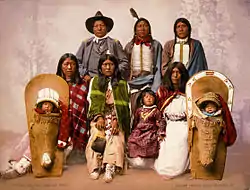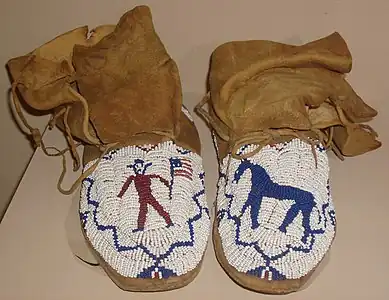Indigenous peoples of the Great Basin
The Indigenous peoples of the Great Basin are Native Americans of the northern Great Basin, Snake River Plain, and upper Colorado River basin. The "Great Basin" is a cultural classification of indigenous peoples of the Americas and a cultural region located between the Rocky Mountains and the Sierra Nevada, in what is now Nevada, and parts of Oregon, California, Idaho, Wyoming, and Utah. The Great Basin region at the time of European contact was ~400,000 sq mi (1,000,000 km2).[1] There is very little precipitation in the Great Basin area which affects the lifestyles and cultures of the inhabitants.


Great Basin peoples
- Fremont culture (400 CE–1300 CE), Utah[2]: 161
- Kawaiisu, southern inland California[3]
- Timbisha or Panamint or Koso, southeastern California
- Washo, Nevada and California[4]
Northern Paiute
- Northern Paiute, eastern California, Nevada, Oregon, southwestern Idaho[3]
- Kucadikadi, Mono Lake Paiute, California
- Bannock, Idaho[3]
Mono
- Mono, southeastern California
- Eastern Mono (Owens Valley Paiute), southeastern California
- Western Mono, southeastern California
Southern Paiute
- Southern Paiute, Arizona, Nevada, Utah[5]
- Chemehuevi, southeastern California
- Kaibab, northwestern Arizona
- Kaiparowits, southwestern Utah
- Moapa, southern Nevada
- Panaca
- Panguitch, Utah
- Paranigets, southern Nevada
- Shivwits, southwestern Utah
Shoshone
- Guchundeka', Kuccuntikka, Buffalo Eaters[6][7]
- Tukkutikka, Tukudeka, Mountain Sheep Eaters, joined the Northern Shoshone[7]
- Boho'inee', Pohoini, Pohogwe, Sage Grass people, Sagebrush Butte People[6][7][8]
- Agaideka, Salmon Eaters, Lemhi, Snake River and Lemhi River Valley[8][9]
- Doyahinee', Mountain people[6]
- Kammedeka, Kammitikka, Jack Rabbit Eaters, Snake River, Great Salt Lake[8]
- Hukundüka, Porcupine Grass Seed Eaters, Wild Wheat Eaters, possibly synonymous with Kammitikka[8][10]
- Tukudeka, Dukundeka', Sheep Eaters (Mountain Sheep Eaters), Sawtooth Range, Idaho[8][9]
- Yahandeka, Yakandika, Groundhog Eaters, lower Boise, Payette, and Weiser Rivers[8][9]
-
- Kuyatikka, Kuyudikka, Bitterroot Eaters, Halleck, Mary's River, Clover Valley, Smith Creek Valley, Nevada[10]
- Mahaguadüka, Mentzelia Seed Eaters, Ruby Valley, Nevada[10]
- Painkwitikka, Penkwitikka, Fish Eaters, Cache Valley, Idaho and Utah[10]
- Pasiatikka, Redtop Grass Eaters, Deep Creek Gosiute, Deep Creek Valley, Antelope Valley[10]
- Tipatikka, Pinenut Eaters, northernmost band[10]
- Tsaiduka, Tule Eaters, Railroad Valley, Nevada[10]
- Tsogwiyuyugi, Elko, Nevada[10]
- Waitikka, Ricegrass Eaters, Ione Valley, Nevada[10]
- Watatikka, Ryegrass Seed Eaters, Ruby Valley, Nevada[10]
- Wiyimpihtikka, Buffalo Berry Eaters[10]
Ute
- Northern Ute
- San Pitch, central Utah
- Seuvarits, Moah Utah area
- Timpanogos, north central Utah
- Uncompahgre (Tabeguache), central and northern Colorado
- Uintah
- White River Utes, Colorado and eastern Utah
- Parianuche, along Colorado River valley in central and western Colorado
- Sabuagana, along Colorado River valley in central and western Colorado
- Yampa
- Parianuche, along Colorado River valley in central and western Colorado
- Southern Ute
- Ute Mountain
- Weeminuche, western Colorado, eastern Utah, northwestern New Mexico
- Absorbed by the Paiute Indian Tribe of Utah
History

The oldest known petroglyphs in North America are in the Great Basin. Near the banks of Winnemucca Lake in Nevada, this rock art dates between 10,500 and 14,800 years ago.[11]
Archaeologists called the local period 9,000 BCE to 400 CE the Great Basin Desert Archaic Period. This was followed by the time of the Fremont culture, who were hunter-gatherers and agriculturalists. Numic language-speakers, ancestors of today's Western Shoshone and both Northern Paiute people and Southern Paiute people entered the region around the 14th century CE.[12]
The first Europeans to reach the area was the Spanish Domínguez–Escalante expedition, who passed far from present day Delta, Utah in 1776.[12] Great Basin settlement was relatively free of non-Native settlers until the first Mormon settlers arrived in 1847. Within ten years, the first Indian reservation was established, in order to assimilate the native population. The Goshute Reservation was created in 1863.[12] The attempted acculturation process included sending children to Indian schools and limiting the landbases and resources of the reservations.
Because their contact with European-Americans and African-Americans occurred comparatively late, Great Basin tribes maintain their religion and culture and were leading proponents of 19th century cultural and religious renewals. Two Paiute prophets, Wodziwob and Wovoka, introduced the Ghost Dance in a ceremony to commune with departed loved ones and bring renewal of buffalo herds and precontact lifeways. The Ute Bear Dance emerged on the Great Basin. The Sun Dance and Peyote religion flourished in the Great Basin, as well.[2]
In 1930, the Ely Shoshone Reservation was established, followed by the Duckwater Indian Reservation in 1940.[12]
Conditions for the Native American population of the Great Basin were erratic throughout the 20th century. Economic improvement emerged as a result of President Franklin Roosevelt's Indian New Deal in the 1930s, while activism and legal victories in the 1970s have improved conditions significantly. Nevertheless, the communities continue to struggle against chronic poverty and all of the resulting problems: unemployment; substance abuse; and high suicide rates.
Today self-determination, beginning with the 1975 passage of the Indian Self-determination and Education Assistance Act,[12] has enabled Great Basin tribes to develop economic opportunities for their members.
Cultures
Different ethnic groups of Great Basin tribes share certain common cultural elements that distinguish them from surrounding groups. All but the Washoe traditionally speak Numic languages, and tribal groups, who historically lived peacefully and often shared common territories, have intermingled considerably. Prior to the 20th century, Great Basin peoples were predominantly hunters and gatherers.
"Desert Archaic" or more simply "The Desert Culture" refers to the culture of the Great Basin tribes. This culture is characterized by the need for mobility to take advantage of seasonally available food supplies. The use of pottery was rare due to its weight, but intricate baskets were woven for containing water, cooking food, winnowing grass seeds and storage—including the storage of pine nuts, a Paiute-Shoshone staple. Heavy items such as metates would be cached rather than carried from foraging area to foraging area. Agriculture was not practiced within the Great Basin itself, although it was practiced in adjacent areas (modern agriculture in the Great Basin requires either large mountain reservoirs or deep artesian wells). Likewise, the Great Basin tribes had no permanent settlements, although winter villages might be revisited winter after winter by the same group of families. In the summer, the largest group was usually the nuclear family due to the low density of food supplies.
In the early historical period the Great Basin tribes were actively expanding to the north and east, where they developed a horse-riding bison-hunting culture. These people, including the Bannock and Eastern Shoshone share traits with Plains Indians.
Today, the Great Basin Native Artists, which was cofounded by Melissa Melero-Moose represents Indigenous visual artists from the region and curates groups exhibitions.[13]
Notes
- Pritzker, Barry M (2000). A Native American Encyclopedia: History, Culture, and Peoples. Oxford: Oxford University Press. p. 220. ISBN 978-0-19-513877-1. Retrieved 2010-06-04 – via Internet Archive.
- D'Azevedo, Warren L, ed. (1986). Volume 11: Great Basin. ISBN 978-0-16-004581-3.
{{cite book}}:|work=ignored (help) - D'Azevedo ix
- Nicholas, Walter S. "A Short History of Johnsondale". RRanch.org. Archived from the original on 2010-10-31. Retrieved 2010-06-04.
- Pritzker 230
- Loether, Christopher. "Shoshones." Encyclopedia of the Great Plains. Retrieved 20 Oct 2013.
- Shimkin 335
- Murphy and Murphy 306
- Murphy and Murphy 287
- Thomas, Pendleton, and Cappannari 280–283
- Than, Ker (15 August 2013). "Oldest North American Rock Art May Be 14,800 Years Old". National Geographic. Retrieved 3 July 2020.
- "History Timeline of Great Basin National Heritage Area." Archived 2013-06-22 at the Wayback Machine Great Basin National Heritage Area. Retrieved 24 June 2013.
- "Melissa Melero-Moose". School for Advanced Research. 2015.
External links
- Great Basin Native Artists, a collective of indigenous artists from the Great Basin
- Great Basin artwork in Infinity of Nations, National Museum of the American Indian


